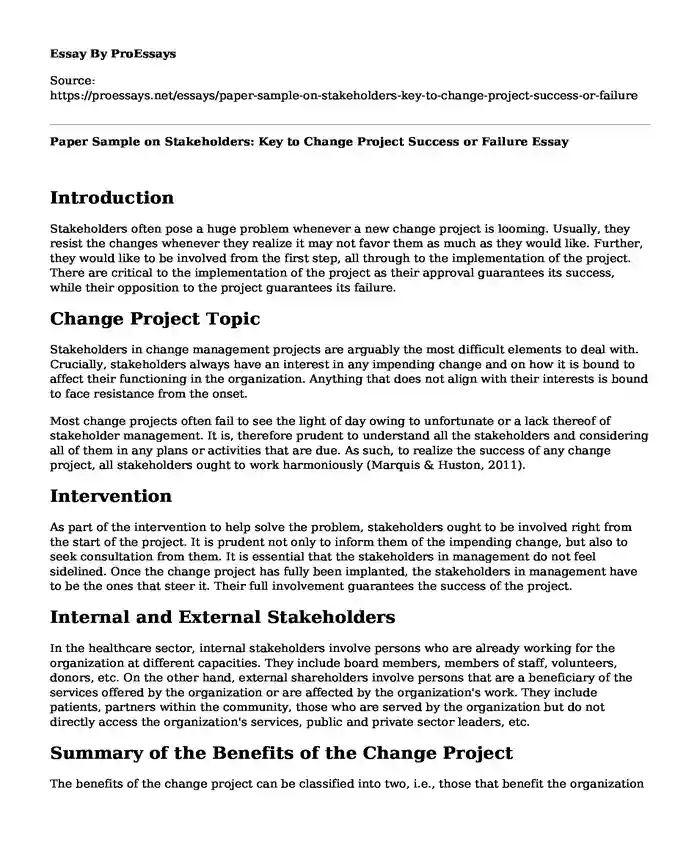Introduction
Stakeholders often pose a huge problem whenever a new change project is looming. Usually, they resist the changes whenever they realize it may not favor them as much as they would like. Further, they would like to be involved from the first step, all through to the implementation of the project. There are critical to the implementation of the project as their approval guarantees its success, while their opposition to the project guarantees its failure.
Change Project Topic
Stakeholders in change management projects are arguably the most difficult elements to deal with. Crucially, stakeholders always have an interest in any impending change and on how it is bound to affect their functioning in the organization. Anything that does not align with their interests is bound to face resistance from the onset.
Most change projects often fail to see the light of day owing to unfortunate or a lack thereof of stakeholder management. It is, therefore prudent to understand all the stakeholders and considering all of them in any plans or activities that are due. As such, to realize the success of any change project, all stakeholders ought to work harmoniously (Marquis & Huston, 2011).
Intervention
As part of the intervention to help solve the problem, stakeholders ought to be involved right from the start of the project. It is prudent not only to inform them of the impending change, but also to seek consultation from them. It is essential that the stakeholders in management do not feel sidelined. Once the change project has fully been implanted, the stakeholders in management have to be the ones that steer it. Their full involvement guarantees the success of the project.
Internal and External Stakeholders
In the healthcare sector, internal stakeholders involve persons who are already working for the organization at different capacities. They include board members, members of staff, volunteers, donors, etc. On the other hand, external shareholders involve persons that are a beneficiary of the services offered by the organization or are affected by the organization's work. They include patients, partners within the community, those who are served by the organization but do not directly access the organization's services, public and private sector leaders, etc.
Summary of the Benefits of the Change Project
The benefits of the change project can be classified into two, i.e., those that benefit the organization and those that benefit individuals. For the organization, since change is a process that is usually planned and managed before its implementation, there is bound to be motivation to see out the entire process (Morris & DeLapp, 1983). Further, the organization is bound to be more efficient and effective in its functioning, as well as aligning the use of resources in the organization.
The Benefits and Challenges Associated with Internal and External Stakeholders
Amongst the advantages of internal stakeholders include increased productivity, a decrease in employee turnover, positive changes based on involving all employees, improvement in supplier relations, etc. As for external stakeholders, the advantages include an increase in the level of customer satisfaction and loyalty and seamless customer experience.
The challenges associated with internal stakeholders can best be summarized in the fact that different stakeholders often play different roles in the functioning of the organization. As such, to effectively manage them, all their inputs ought to be considered, and this could prove to be a daunting task. With regards to external stakeholders, their inability to cope up with the changes could disrupt an organization's functioning (Morris & DeLapp, 1983).
Conclusion
In conclusion, an effective change project brings forth a seamless transition within the organization, without necessarily interfering with the morale or productivity of the individuals. Furthermore, involving the staff allows addressing any concerns that may arise owing to the changes. When done and managed appropriately, there's bound to be minimal resistance. A general improvement in morale, cooperation, collaboration, and effective communication is witnessed. Those working for and within the organization have a chance to affirm their loyalty to it (Marquis & Huston, 2011).
References
Advantages and Disadvantages of Stakeholders: Everything You Need to Know. (2017). Retrieved July 08, 2020, from https://www.upcounsel.com/advantages-and-disadvantages-of-stakeholders
Benefits of Change Management. (2013). Retrieved July 08, 2020, from https://www.change-management-coach.com/benefits-of-change-management.html
Marquis, B. L., & Huston, C. J. (2011). Leadership Roles and Management Functions in Nursing: Theory and Application. Philadelphia: Wolters Kluwer Health/Lippincott Williams & Wilkins.
Morris, P. W. G. & DeLapp, S. E. (1983). Managing change through project management. Project Management Quarterly, 14(2), 60–70.
Understanding and meeting your stakeholders' needs with market research. (2017, June 07). Retrieved July 08, 2020, from https://www.tti-global-research.co.uk/understanding-and-meeting-your-stakeholders-needs-market-research
Cite this page
Paper Sample on Stakeholders: Key to Change Project Success or Failure. (2023, Sep 30). Retrieved from https://proessays.net/essays/paper-sample-on-stakeholders-key-to-change-project-success-or-failure
If you are the original author of this essay and no longer wish to have it published on the ProEssays website, please click below to request its removal:
- Organizational Behavior Questions and Answers
- Teamwork Contributes to the Acquisition of Leadership Skills
- Paper Example on Garibaldi: A Firm Decision Maker for Italian Freedom
- West Jet Airlines' IT Governance
- Essay Sample on Captain Avery's Golden Age of Piracy: Building a Community with Abused Men on Madagascar
- Exploring Ethical Dilemmas: Applying SRM's Decision-Making Model - Essay Sample
- Leadership and Entrepreneurship - Free Report Example







